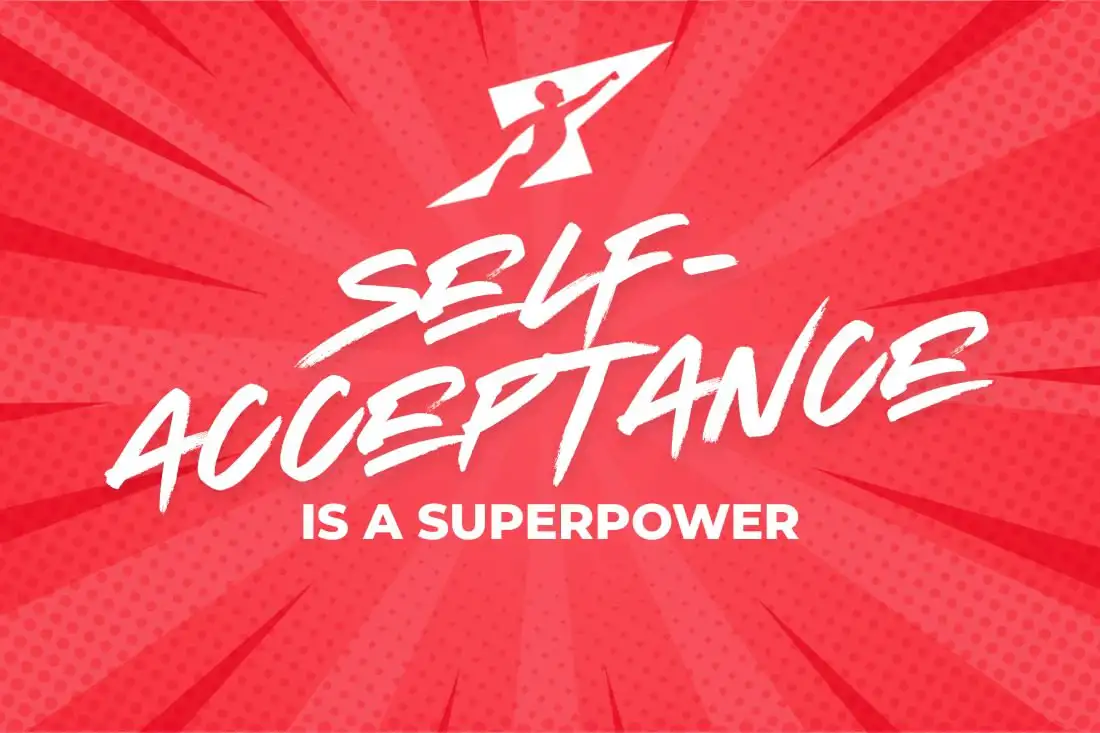Self-Acceptance is a Superpower
“You should’ve asked her to dance”
The positivity in my dad’s voice was a stark contrast to my sulking in the backseat of our minivan.
We’d just left the party. It was a sweet 16 for the daughter of one of my dad’s colleagues. She was blonde, pretty, and seemed to have a lot of friends. Clearly, not the type of girl who’d ever go for a guy like me.
Why would she? I was short with red hair and freckles. I wasn’t out of shape but I certainly wasn’t as fit as I felt I should’ve been. And sure, I made her laugh, but that was just my role, the class clown, the court jester. I was doomed to be alone.
“She was smiling at you the whole night.”
This wasn’t helping.
I probably didn’t say more than a few words the whole ride home.
Critical Reflections
We pulled into the driveway and after walking inside, I said goodnight and went straight to my room.
I sat at the edge of the bed, replaying the night in my head. My feet hung off the side, not touching the ground. Another reminder of these short stubby legs of mine.
I hopped off the bed and walked over to my mirror. I looked at my reflection and started to pour over everything I would change.
- I wanted green eyes or at least blue eyes, not these boring brown ones.
- I wanted dark hair, not this weird reddish tinted nonsense.
- I wanted to be taller, fitter, better skin, and a smaller nose.
I had so many complaints, so many things I wanted to be different.
One that kept swirling was how badly I wanted to be taller. At this point in my life, all I wanted in the world, was to become a professional basketball player. It was my obsession, my purpose, my everything.
But how would I ever make it in a league filled with giants?
I looked up and caught my own eyes in the mirror. It was one of those moments where everything else stops.
It’s just you, with yourself, by yourself.
The Truth *Clicks*
I remember staring into my own eyes, talking to myself, checking in.

I asked myself something to the effect of “so, what’s our plan to get taller?”
It was a genuine question about how I might change myself so that I might follow my dreams.
It happened in an instant — something clicked!
All of a sudden, I saw a simple truth staring directly into the core of me:
I wasn’t going to get much taller.
And immediately, all I could think was, if couldn’t change it why was I wasting emotional energy on it?
I then started thinking beyond my height, about everything else I wanted to change. I couldn’t change any of that either.
We Walk Alone
Next, it occurred to me that I was the only person who was ever going to have to spend my entire life with me. That made me think how comical and absurd it would be for me to give any weight to any of the thoughts, opinions, and judgements of others about any parts of me, especially the parts beyond my control.
In the end, I was the only person who had to live with this. I remember thinking: this is who I am, and I can spend my entire life fighting that or I can accept it right now.
I couldn’t unsee it, I couldn’t unhear it, I couldn’t unthink it. I didn’t even have a choice.
The only thing that made sense from that moment forward, was to accept myself, exactly as I was.
I think I was 14 at the time.
Making It Sound Easy
I haven’t told this story to many people partly because in my 31 years of life since then, I’ve met so many people who struggle with self-acceptance.
I’ve watched people who spend years learning to love and accept themselves, trying everything from therapy to drugs to lying to themselves and masking their insecurities. Sharing my story has always felt awkward and inappropriate.
- I never want to minimize or dismiss anyone’s experiences
- Given the abundance of privileges that I hold, I never want to suggest that I understand what someone else is going through, or to ignorantly assume it would be an easy process for everyone.
At the same time, because of how I came to accept myself, I do tend to have a hard time understanding why it is so hard for people.
To this day, my story still doesn’t even feel particularly special. I didn’t do anything audacious or remarkable. I wasn’t trying to solve that problem or convince myself. It kind of happened by accident.
But what happened for me in that moment does feel very different from what I see most people going through.
For me, it felt similar to the moment when you finish a Sudoko puzzle, figure out a math problem, or understand how something works.
So, it got me thinking, what if I could help it click into place for other people?
How to fully accept yourself (Step-by-Step)
What I’m about to propose is less of a self-help process, and more of sequence of logic.
It might work for you, it might not…this is the first time I’m sharing it.
If you are skeptical that this will work, that’s good. I want you to look for what is untrue in each step. Remember, this is a sequence of logic. Therefore, it can only work if the logic is sound. The more you challenge this process, the more effective it will be.
Begin.
Step 1: The Workspace
The first step is to connect with someone you mostly take for granted…yourself. When you are alone, in a place where you feel safe and comfortable, look at yourself in the mirror until you feel completely alone, with yourself.
This is the channel to open up so you can get really honest with the only person who matters in this conversation.
This is an important setup step. Don’t progress to step 2 until you are alone and present with yourself.
Step 2: The Constant
As you are staring into your eyes, locked into the present moment, ask yourself, “who else is here with me right now?”
The answer you will inevitably find, is no one.
It is just you in there. It’s always been just you in there. It will always be just you in there.
That means that whatever thoughts you’re thinking about the person in the mirror, are coming from inside of you.
Who else gets to, or should get to, decide what you do with what you hear?
The answer you will inevitably find again, is no one.
It’s just you. That means what happens in the next steps, is entirely up to you.
Step 3: The Variables
By now, you should be alone with yourself, not just in the present moment, but also past and future. You are sitting with the reality that you are the only passenger and operator in the person suit you’re looking at and from.
Now, look at every part of yourself that you have yet to accept.
Review every physical feature. Every personality trait. Every piece of your life story.
Ask yourself for each one: Is this something I can change?
You will likely find they fall into three clear categories:
a. Fixed traits (cannot change)
Examples: Age, height, genetics, neurotype, past experiences.
b. Adaptable traits (change how they are expressed or perceived)
Examples: Hair color, clothing style, how much you share about disabilities, or the language you use to describe yourself.
c. Malleable traits (can intentionally change over time)
Examples: Fitness level, career, relationship boundaries, how you speak or present yourself.
Step 4: Solve the Equation
While still looking at yourself in the mirror, reflect on each trait you identified in Step 3.
Ask yourself the following:
a. For Fixed traits (cannot change):
If this cannot be changed, what will happen if I continue spending time and energy trying to change it?
What result have I gotten from that effort so far?
What result am I likely to get if I keep doing it?
b. For Adaptable traits (change how they are expressed or perceived):
If I’m able to alter this aspect of myself, will I be happy? If I don’t, so what?
Will this actually solve my discomfort—or just delay facing it?
c. For Malleable traits (can intentionally change over time):
If change is possible, and it matters to me, what’s stopping me from starting?
(If I’m unwilling to change it, what does that tell me about how much it really matters?)
What all of these ultimately lead to, is a resolution to the question: where should my time and energy logically go next?
It is an exercise that terminates at the point that you determine a clear and unambigious next step that is either to control, influence, or accept.
Where this all leads
What I’ve suggested is simple, but probably not easy. However, it might just click for you. If it does, it will change the rest of your life.
Because when you fully accept yourself…
- you become free from the burdens of your own self-judgement.
- you stop wasting time seeking other people to validate your worth.
- you finally realize that no one can hurt you.
This is most of what you might learn if you sat down to read the 288 pages of philosophy and self-help in The Courage to be Disliked by Ichiro Kishimi and Fumitake Koga. With more than 10 million copies sold, this best seller uses a Socratic dialogue between two characters to go through the key ideas of the psychology of Alfred Adler.
But when I tried to read it, all I saw was a set of principles that clicked for me one fateful day in my moody teenage years.
To paraphrase the relevant bits:
- Our desire for others to validate us is a trap.
- Life is not a competition.
- You can change; happiness is a choice.
- The courage to be disliked is the courage to be free.
You can do this today. Literally, right now, you can go into the private bathroom at your office, and have a moment in the mirror.
It’s not a multi-year process. It’s not a 30-day program that I have to sell you. It’s what a dorky 14-year old came up with after beating himself up for not asking the girl to dance.
A lot can change when you start loving and accepting who you are.

